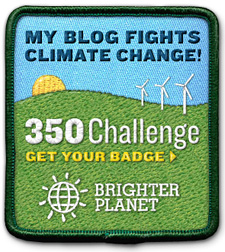
Wednesday, December 23, 2009
Four Global Warming ads that make you think
Global warming and climate change are not the main topics of this blog as I try to bring you environmental issues that are not very known amongst the general public. However, I think these four ads are really worth a quick look.
Monday, December 7, 2009
"I am sorry" - Greenpeace 2020 Banners

Greenpeace, along other associations, are putting pressure on the leaders, or at least trying to. Since last week, travelers arriving in the Copenhagen's international airport will come across the following banners. These depict different leaders of developed nations apologizing in 2020 (ten years from now) for not taking the right decisions. I'll let you judge by yourself.
Monday, November 30, 2009
"Who Killed the Electric Car?" - Documentary Film

The Prius, thus a commercial success, still uses gas. I can't help wandering how in 2001 a hybrid car consuming gas is considered as an innovation while back in the mid 90's, fully working electric cars were working perfectly?
Well, the answer relies in the documentary below, Who killed the electric car?. This documentary was produced in 2006 and explains in details how the powerful petrol and automotive lobbies, along with the US government, put a full stop to the commercialization of the General Motors EV1 car (picture above). I'll let you judge by yourselves. Enjoy this 1,5h documentary film (divided in 10 episodes).
Thursday, November 26, 2009
"Pollution in China", a photo-documentary by Lu Guang
 China has slowly become the World's most powerful country, demographically but commercially as well. With the effect of globalization, companies from developed countries outsource their production in this country where the labor remains very cheap. But this economic growth is not as good as it seems. In fact, many issues accompany the development of this country, often to the detriment of local populations and the environment: Poverty, diseases, malformations, premature deaths, toxic rivers, dying ecosystems, etc
China has slowly become the World's most powerful country, demographically but commercially as well. With the effect of globalization, companies from developed countries outsource their production in this country where the labor remains very cheap. But this economic growth is not as good as it seems. In fact, many issues accompany the development of this country, often to the detriment of local populations and the environment: Poverty, diseases, malformations, premature deaths, toxic rivers, dying ecosystems, etcThe photo documentary below, simply entitled "Pollution in China", is the work of Lu Guang, a Chinese photographer. I have inserted a few pictures below to show you how sad, disgusting and heart breaking some of these pictures are. You can also view the full gallery with the comments translated in English on China Hush or the original photo gallery (in Chinese) on Fengniao.
These are sadly beautiful pictures definitely worth sharing.
Wednesday, November 25, 2009
World's biggest garbage dump: The Pacific Ocean
"Twice the size of Texas and 7 million tons", this is what could describe best the two floating garbage dumps in the North Pacific spreading from Hawaii to Japan. Garbage from North America and North East Asia that ends up in the Pacific Ocean is likely to float to the center of the North Pacific Ocean. After travelling hundreds of miles with the currents, these millions of tons of plastic waste concentrate into this area and form a vast landfill in the heart of our planet's biggest ocean.
The plastics, by their chemical nature, do not biodegrade like other materials. Instead, they will photodegrade (turn into smaller pieces due to the action of sunlight) until they reach tiny sizes. These plastics are then swallowed and digested by all sorts of life forms: fish, sea mammals, birds, etc. As predators eat contaminated preys, they themselves absorb the plastics. And in the end, we humans are also be affected. As you will see in the videos below, there is so much plastic floating around that it exceeds by 6 the quantity of plancton in some areas!
The plastics, by their chemical nature, do not biodegrade like other materials. Instead, they will photodegrade (turn into smaller pieces due to the action of sunlight) until they reach tiny sizes. These plastics are then swallowed and digested by all sorts of life forms: fish, sea mammals, birds, etc. As predators eat contaminated preys, they themselves absorb the plastics. And in the end, we humans are also be affected. As you will see in the videos below, there is so much plastic floating around that it exceeds by 6 the quantity of plancton in some areas!




